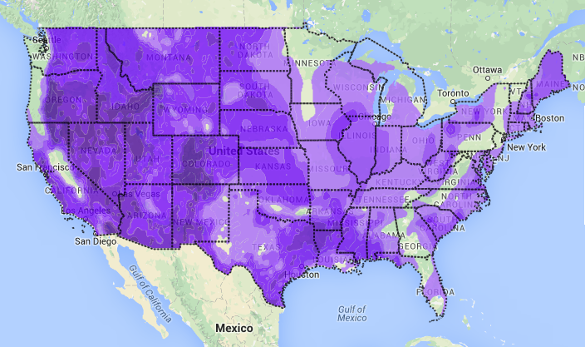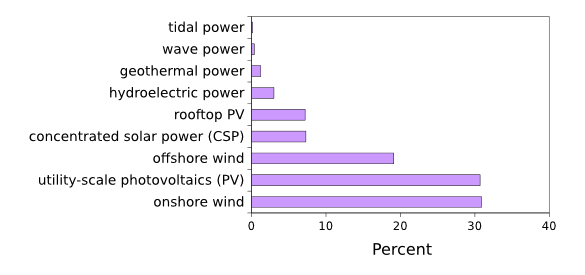Renewables 2050
June 25, 2015
Food is a
renewable resource.
Farmers are careful to save enough
seed to ensure the next year's
harvest, and such careful planning has enabled our
civilization to rise above our
hunter-gatherer period of about ten thousand years ago. In that period,
hunters were careful not the deplete the numbers of
wild animals. Maintenance of animal resources was aided by
animal behavior, itself, but the
rifle tipped the
equilibrium too far in favor of
man, and that's when the hunter-gatherer
lifestyle started to fail.
As our
energy needs have increased, we've traded our
firewood-
harvesting tools for advanced
coal,
natural gas, and
oil extraction technologies. These advanced technologies are the "rifle" of our energy harvesting, and we've been reaping the benefits of this easy energy harvesting for
decades. Presently, we need to advance from our hunter-gatherer mindset in energy and advance to a
renewable energy era.

William Frederick "Buffalo Bill" Cody (1846-1917)
Buffalo Bill Cody was contracted by the Kansas Pacific Railway to supply bison (a.k.a., Buffalo) meat for its workers.
Cody is documented to have killed 68 bison in an eight hour period.
(Illustration from Die Gartenlaube, Ernst Keil's Nachfolger (Leipzig, 1877), p. 583, via Wikimedia Commons.)
Is it possible for renewable energy sources to supply all
US energy demands? If this were possible, how quickly could this happen? These questions are addressed in a massive, 133-page
paper in the journal,
Energy and Environmental Science, by
scientists and
engineers from
Stanford University (Stanford, California) and the
University of California, Berkeley.[1-2] The paper proposes a
roadmap for 80-85% conversion to renewables by 2030, and 100% conversion by 2050.
The staples of renewable energy are
photovoltaics and
wind power, and we presently see quite a few
solar panels and
wind turbines dotting our
landscape. Photovoltaics aren't the only type of
solar energy, and I've described some
solar thermal approaches in previous articles (
Solar Salt, July 30, 2010,
Solar Energy Scorecard, April 30, 2012, and
Solar Steam, August 15, 2014 ). I wrote about wind energy in a
previous article (Worldwide Wind, September 17, 2012).
As can be seen in the figures below, some
US states are favored by high
insolation, while there's considerable wind power in many other states.

Most of the contiguous United States has a direct solar irradiation greater than four kilowatt-hours per square meter per day. (Source: National Renewable Energy Laboratory. Click for larger image with legend.)[3)]

High wind speeds are accessible throughout the contiguous United States, with some regions having wind speeds greater than seven meters per second. (Source: National Renewable Energy Laboratory. Click for larger image with legend.)[4)]
Other major renewable energy sources are geothermal,
wave and
tidal. While my location in
Northern New Jersey is devoid of geothermal energy, there's a lot in the rest of the country, as shown in the figure. Wave power density for most of the US
coast is about 10
kilowatts/
meter. I wrote about geothermal energy, tidal and wave energy in previous articles (
Geothermal Energy, November 9, 2011 and
Tidal and Wave Energy, March 24, 2014). As detailed in
another article (Salt Water Energy, May 20, 2011) there's a way to extract energy from
freshwater flow to the
sea using
supercapacitors.

Geothermal energy resources in the contiguous United States. Alas, Northern New Jersey, home to Tikalon, has no available geothermal resources. (Source: National Renewable Energy Laboratory. Click for larger image with legend.)[5)]

wave power and tidal power resources in the contiguous United States. Wave power density for most of the US coast is about 10 kW/meter. (Source: National Renewable Energy Laboratory. Click for larger image with legend.)[5)]
The study shows that each state can meet its entire energy demands by 2050 using a mix of the wind, solar, geothermal, hydroelectric, and tidal and wave resources available to them.[2] The proposed mix of these energies for each state is detailed on the Solutions Project Web Site. As an example, the 2050 renewable mix for the US state of
Georgia is listed in the table, below.
In the composite, the 2050 mix of renewables for the
contiguous United States would be as follows:

Percentage of each renewable energy source needed to completely replace all energy sources in the contiguous United States in 2050. (Graphed using Gnumeric with data from ref. 1.)[1)]
As can be imagined, the
analysis for such estimates was straightforward, but tedious. The research team looked at each state's insolation, as well as the number of
south-facing, non-shaded
rooftops suitable for photovoltaic panels. Wind maps were used to determine the capacity for onshore and offshore turbines, and it was found that
cost-effective geothermal energy was available for just thirteen states.
Hydroelectric capacity was held at present levels, but
energy efficiency improvements for existing
dams were taken into account.[2]
The analysis also contains the following notable points:
•
Conversion to all renewables in the contiguous United States would provide 3.9 million 40-year construction jobs and 2.0 million 40-year operation jobs just for the energy facilities. These exceed the 3.9 million jobs estimated to be lost in conventional energy occupations.[1]
•
Conversion to renewables would also eliminate between 12,000 and 104,000 early deaths per year in 2050 from air pollution, with associated cost of between 0.5–14.3 percent of the 2014 US gross domestic product.[1-2]
•
Conversion to renewables would also eliminate between 1.9 and 7.1 trillion dollars per year in 2050 from global warming costs to the world from US emissions.[1-2]
•
Such conversion in 2050 would offer a per capita annual saving of between $190 and $320 in energy costs.[1]
•
The land footprint for all this is just 0.42% of US land.[1-2]
Says
paper co-author,
Mark Jacobson, a
senior fellow at the
Stanford Woods Institute for the Environment and at the
Precourt Institute for Energy,
"The main barriers are social, political and getting industries to change. One way to overcome the barriers is to inform people about what is possible... By showing that it's technologically and economically possible, this study could reduce the barriers to a large scale transformation... When you account for the health and climate costs – as well as the rising price of fossil fuels – wind, water and solar are half the cost of conventional systems... A conversion of this scale would also create jobs, stabilize fuel prices, reduce pollution-related health problems and eliminate emissions from the United States. There is very little downside to a conversion, at least based on this science."[2]
References:
- Mark Z. Jacobson, Mark A. Delucchi, Guillaume Bazouin, Zack A. F. Bauer, Christa C. Heavey, Emma Fisher, Sean B. Morris, Diniana J. Y. Piekutowski, Taylor A. Vencill, and Tim W. Yeskoo, "100% clean and renewable wind, water, and sunlight (WWS) all-sector energy roadmaps for the 50 United States," Energy and Environmental Science (2015), DOI: 10.1039/c5ee01283j (PDF file via Stanford University Web Site).
- Stanford engineers develop state-by-state plan to convert U.S. to 100% clean, renewable energy by 2050, Stanford Report, June 8, 2015.
- Interactive Mapping Tools, National Renewable Energy Laboratory, U.S. Department of Energy, Office of Energy Efficiency and Renewable Energy.
- Wind Prospector, National Renewable Energy Laboratory, U.S. Department of Energy, Office of Energy Efficiency and Renewable Energy.
- Renewable Energy Atlas, National Renewable Energy Laboratory, U.S. Department of Energy, Office of Energy Efficiency and Renewable Energy.
- The Solutions Project Web Site.
- Mark Jacobson Stanford University Web Site.
Permanent Link to this article
Linked Keywords: Food; renewable resource; farmer; seed; harvest; civilization; hunter-gatherer; hunter; wildlife; wild animal; ethology; animal behavior; rifle; equilibrium; human; man; lifestyle; energy; firewood; harvesting tool; coal; natural gas; petroleum; oil; natural resource extraction; technology; technologies; decade; renewable energy; William Frederick "Buffalo Bill" Cody (1846-1917); contract; Kansas Pacific Railway; bison; meat; worker; Wikimedia Commons; United States; US; scientific literature; paper; Energy and Environmental Science; scientist; engineer; Stanford University (Stanford, California); University of California, Berkeley; technology roadmap; photovoltaic; wind power; solar panel; wind turbine; landscape; solar energy; solar thermal energy; US state; insolation; direct solar irradiation; kilowatt-hour; square meter; National Renewable Energy Laboratory; contiguous United States; meters per second; geothermal energy; wave power; tidal power; Northern New Jersey; coast; kilowatt; meter; freshwater; flow; ocean; sea; supercapacitor; Solutions Project Web Site; Georgia; concentrated solar power; CSP; hydroelectricity; hydroelectric; offshore wind; tidal turbine; Gnumeric; analysis; south-facing; rooftop; cost-effectiveness analysis; cost-effective; energy conversion efficiency; dam; construction; technician; operator; death; air pollution; gross domestic product; global warming; greenhouse gas emission; per capita; scientific literature; paper; co-author; Mark Z. Jacobson; senior fellow; Stanford Woods Institute for the Environment; Precourt Institute for Energy; social; political; industry; industries; technology; technological; economics; economical; health; climate; fossil fuel.